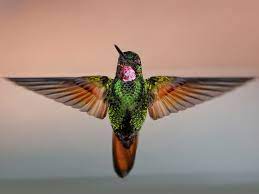Where Do Hummingbirds Go In The Winter? A Guide
When it comes to Flying Jewels, as Hummingbirds are often referred to, there is much wonder and intrigue. Where do these tiny birds migrate to during the winter months? It is a common question among birdwatchers and nature enthusiasts. Join us as we explore the amazing migratory journey that hummingbirds embark on every winter. Learn all the facts on where they go and why, plus some tips on how to help them on their way. In this guide, you’ll find out just what these tiny creatures do during the colder months, and how you can help them in their mission to return to their summer homes.
1. What Hummingbirds Do in the Winter
During the winter months, hummingbirds migrate south to warmer climates. In the United States, this means that they migrate to the southern states, Mexico and Central America. However, some hummingbirds may choose to remain in northern climates, as long as there is an adequate food source. Hummingbirds will also look for sheltered areas such as wooded areas, large shrubs, and evergreen trees to find shelter and food. During this time, they may also form flocks with other hummingbirds, which can help to keep them warm and conserve energy.
2. Where Hummingbirds Travel To in the Winter
When the winter season rolls around, many hummingbirds travel south to warmer climates. This is known as the winter migration, and it’s essential for their survival. Hummingbirds typically migrate to areas of Central and South America. Some species will even travel as far as Mexico, the Caribbean, and the Galapagos Islands. To make the journey, these tiny birds fly up to 500 miles a day! By the time they reach their destination, they’ll have flown well over 10,000 miles from their summer breeding grounds.
3. What to do to Prepare for Hummingbird Migration
Preparing your yard for hummingbird migration is an important part of being able to enjoy the beauty of these birds as they travel between their winter and summer homes. Here are some tips to help you get ready:
1. Plant a variety of flowers that bloom at different times of the season. This will provide a source of nectar for the hummingbirds as they migrate through your area.
2. Provide feeders and water sources throughout your yard. Hummingbirds need both food and water to stay healthy.
3. Trim back the vegetation around your feeders and water sources so that the birds can easily access them. Make sure there are no potential hiding spots for predators, such as cats or squirrels.
4. Consider creating a hummingbird-friendly habitat, such as a birdbath, shrubs, and perches to give the hummingbirds a place to rest and relax.
By following these tips, you can create an inviting environment in your yard and enjoy the beauty of hummingbirds as they migrate through your area.

4. How to Attract Hummingbirds in the Winter
Attracting hummingbirds to your outdoor area in the winter can be tricky, since many of them migrate to warmer climates during the cold months. However, there are some things you can do to entice them to stay and visit your garden. By providing food, water, and shelter, you can make your garden a cozy and inviting spot for them to visit during the cold winter months.
Plant native flowers that bloom in the winter, such as winter heather, snowberry, and snowdrop. Hang a hummingbird feeder filled with a sugar-water mixture and keep it filled during the winter. Finally, provide them with places to hide and stay warm by ensuring your garden has plenty of shrubs and trees that provide shelter and protection.
5. Potential Dangers for Hummingbirds in the Winter
Winter can be treacherous for hummingbirds, especially for those that remain in cold climates. Here are five potential dangers they face during this season:
1. Starvation: Hummingbirds need to feed on a daily basis, and it can be hard to find food sources in the winter. Hummingbirds need to consume their own body weight in food each day.
2. Extreme cold: Hummingbirds are not adapted to handle extreme cold temperatures and can freeze if they get too cold.
3. Predators: Predators are a larger threat to hummingbirds in the winter, as they are easier to spot and capture in the diminished foliage.
4. Disease: Hummingbirds are more susceptible to disease in the winter due to a weakened immune system caused by lack of food.
5. Migration fatigue: Long migrations can be dangerous for hummingbirds and can cause dehydration, exhaustion, and even death. They can also lose their way and end up in unfamiliar areas where food and shelter is not available.
Conclusion
Ultimately, where hummingbirds go for the winter largely depends on their species and where they live. Some species will migrate south for the winter, while others stay in their habitats year-round. Regardless of where they go, it’s important that we provide them with the resources they need to survive, such as nectar-rich plants, water, and nesting sites. By understanding their habits and needs, we can create an environment that will help these beautiful creatures thrive.
